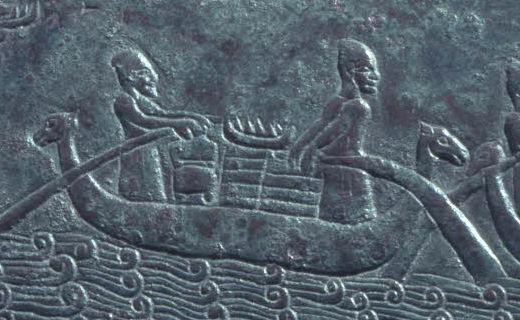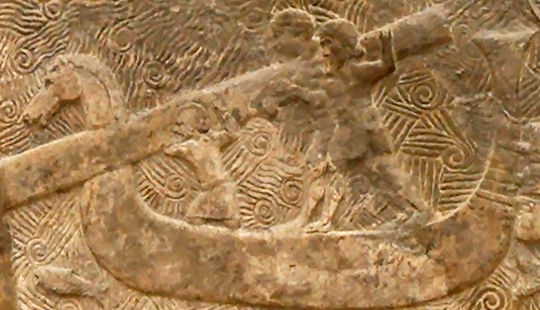Prows with horse-heads on Phoenician ships
Phoenician ships had horse-head prows because the word for “jumping” or “springing” horses was פנך pnk, almost the same word as Punic, and derived from the same root pn for “turning”.
Phoenician ships & boats with horse-heads
Phoenician ships & boats are often depicted as having horse-heads on their prows. Sometimes there’s a horse-head on the stern as well.

Phoenician boats with horse-head prows & sterns ferry goods from Tyre to the mainland.
(from Balawat gate bronze band, now in British Museum)

Phoenician ships with horse-head prows transporting cedar logs for Sargon.
(from Dur Sharukkin, now in Louvre)
More slabs from the horse-head ship series can be seen at the Louvre website:
- Horse-head ships towing timber 1
- Horse-head ships towing timber 2 (detail)
- Workers pulling timber 1 (2nd photo)
- Workers pulling timber 2 (detail)
Semitic pnk meaning “springing” horse
The Phoenicians were said to be a seafaring people, with the narrow coastal strip of the Levant having little to no plains. They would not have a great cavalry, and while the merchants certainly traded horses, it was not their main export or import good.
Why then did Phoenician shipowners commission their ships & boats to be built with horse-head prows?
The explanation is that it’s all a pun, as usual: The Semitic word for a “springing” horse was פנך pnk pinnuk, written & pronounced much like “Punic” or “Phoenician”. Saying “springer” was like saying “Phoenician”, in the Phoenician language.
Aramaic pnk = springing horse
Confirmation through horses on coins
We can get some confirmation from the mainstream on this punnery: Phoenician (and Greek) coins also very often depict prancing horses on one side, or a palm tree, or both. And for the palm tree, even the mainstream has to admit that it’s a visual pun, as phoinix means “date palm”, but also “Phoenician”. The horse symbol is still officially a mystery. But that’s because pnk for “springing” is ancient Aramaic vocabulary, not found in Hebrew or modern Aramaic, so few people know the word.
Since the palm is officially a pun for “Phoenician”, and I found a word for horses that is close to “Phoenician”, I see this as confirmation that the horse is also a pun.
Series I introduces two key motifs that continued to appear regularly on Carthaginian coinage throughout its history: the horse and the palm tree. The significance of both symbols is disputed […]
The usual interpretation of the palm tree is that it was a type of visual pun intended to signify the minting authority, since the Greek word for palm tree, phoinix is also the Greek word for 'Phoenician/Punic'. This kind of visual pun, often known as a ‘canting type’, was common on classical Greek coinage, particularly in Sicily, where prominent examples appear at Himera, Selinus, Zancle, and Leontini.
Etymological relation to other puns
The words for “springing” & “Phoenicians” are etymologically related: Both are derived from the word root √pn for “turning” & “changing”: Springing horses quickly turn directions, and the merchant-bankers were exchanging wealth.
For a full derivation with many other meanings, see the entries for the Phoenicians and the root √pn.
Proof in the horse context is that the main Semitic term for “horse” is סוס sws, which has the same basic meaning: The same word סוס sws is also used for swallows & lilies, all used in aristocratic heraldry. It’s even used for knives & worms! What do all these things have in common? It’s the curve: Horses & swallows display fast zigzag movements, and the lily has curved petals.
On coins, the horse may even be a double-pun, as the main word for “horse” is sws, which puns with zwz for “coin”.
A similar pun on Phoenician ships’ prows were the eyes.
Modern references to the horse pun are the horse-head prow sculpture of the National Bank of Hungary, and the spook name Springer.
